#is this full of christian symbolism and references? yes
Text

Rex Furum
King of the Thieves
#is this full of christian symbolism and references? yes#i have to use that mythology special interest for something afterall#chrollo#chrollo lucilfer#kuroro#hxh#hunter x hunter#hunterxhunter#chrollo hxh#phantom troupe
23 notes
·
View notes
Text
GUYS. I HAVE A THEORY. IT’S SUCH A GOOD THEORY. ACTUALLY IT’S THE BEST. Actually I’m just gonna go ahead and call this canon. I’m staking my entire identity on it.
So, I was gonna do an in depth art post bouncing off this excellent bit of research. I was expecting some thematic hints a la Hannibal and much fun to be had.
I decided to start with this:

Francis Bacon’s Three Studies for Figures at the Base of a Crucifixion, which hangs on the wall in the Dubai apartment.

Let’s sidestep the Christian connotations of the crucifixion* IMO the Christ bit is misdirection (mostly. We’ll come back to that)
Armand: Witnesses to Christ’s agony. Mr Bacon also referred to these as the Three Furies.
Who are they? The Furies/Erinyes are Ancient Greek Goddesses of vengeance. "The Erinyes, that under earth take vengeance on men, whosoever hath sworn a false oath" ... They are traditionally depicted as … preoccupied with avenging patricide and matricide by hunting down and killing violent criminals ... Their task is to hear complaints brought by mortals against the insolence of the young to the aged, of children to parents, of hosts to guests.” (wiki)
Kinda on point for a vampire that tried to kill his maker, no? Or for a vampire that’s abusing the guests in his home? Or an old man shit-talking two much older vamps. (lol jk not you Danny boy, you trash them all you want bb).

Armand: We’ve received an aggressive offer for the Bacon triptych.
Louis: Oh? I didn’t know we’d made it available.
Armand: It’s a new name, so I’ll have to run due diligence.
Hmm, who could possibly be being setup to enter late season under cover as some innocuous buyer? Who would Armand let into his theatre home in order to wreck it? Who’s presence/interest/existence would he keep from Louis? Who better to complete Bacon's intention and provide the crucified final figure of the set, but...

YES! Our favourite victim of patricide. The ultimate Daddy Vampire. Lestat de fucking Lioncourt.
Guys there’s a reason I’ve been calling him White Vampire Jesus and it’s not (just) because I find myself hilarious.
Real Rashid: The lawyer for the buyer is ready for the teleconference.
Not a massive deal, rich people make lawyers do things for them. But so do VAMPIRES WHO DON’T WANT TO BE IDENTIFIED.
But yeah, lets’ get into that phone call. Mr Philips, the lawyer, is introduced to Mr du Lac (like, in case anyone was wondering how Lestat knew it was Louis who owned it, just fucking use your real name Louis, sure.) The buyer wants it for her husband (GUYS. HE WANTS IT FOR LOUIS).
This is episode 2.03 and, guys, Lestat is EVERYWHERE in this episode. We get Armand opening up, but not about his full past, just about his past with Lestat.

Dreamstat dogs Louis’s footsteps

Louis admits to Armand that Lestat was his maker in this episode.


And the scene directly before the lawyer calls?


Louis and Claudia are talking about Lestat, it moves on to Bruce, but it starts with Lestat.
We could also talk about how, this season, as the focus has moved away from Loustat to Loumand, the action has moved away from the main room with the Triptych, to the tree room and the dining room.
Lets start with the tree room, where Armand (the clinging vine) reaches, but never touches Louis (the tree).


"For woman is a branching tree,
and man a clinging vine.
And from your branches carelessly,
he’ll take what he can find."
(Let no man steal your thyme, trad)
Too much? Then how about the dining room of equally symbolic paintings. (and, side note. Paintings have been IT this season. This is the Armand season, the Amadeo season, the Louis photographer season, the breaking into museums to look at or steal art season. If S1 was music, S2 is art).
The dining room where we find the Ron Bechet, Transformation (A TREE AND VINES FFS), representing Louis (or Loumand) and the (stolen - can we take a moment to appreciate the hilarity that is Louis and Armand dressing up as police officers to carry out one of the biggest art heists in recent history?) Rembrandt, Christ in the Storm on the Sea of Galilee representing Daniel (Fear and Faith).
You can see them more clearly in the S1 scene where Dan and Louis are at either end of the table, each before their own painting.


But also in S2 in combo with the Marius christ-and-demons, representing Armand (or representing Armius?? Lol do they have a ship name? kill me now). I find it very interesting how Armand is sometimes framed with Dan's painting behind him and at other times with Louis', almost like he's being pulled between the two.


Anyway. Point is the GIANT RED ORANGE LESTAT CHRIST SYMBOLISM is suspiciously out of frame this season.
See the difference in framing here in Season 1: (note, this is DanLou first meeting. It's BEEN THERE FROM THE BEGINNING)

And this itty bitty corner shot in Season 2:

And when does the triptych come back into frame? Oh just DIRECTLY AFTER THIS BIT OMFG:


Me too, Dan. Me too.
The triptych has been on the wall from the start of the show. Looming over everything, haunting the narrative, like a giant bleeding meta signpost.
#While we’re doing art#How about Dan inspecting Marius’s painting on the dining room wall and the Daniel/Armand:#“do you hear that?”//“we call it the groan”#Yeah. I know. I know#Marius can’t be locked in the basement being slowly tortured to death#Fine. But a girl can dream#interview with the vampire#the vampire armand#louis de pointe du lac#devil's minion#daniel molloy#lestat de lioncourt#iwtv spoilers#iwtv speculation
161 notes
·
View notes
Text


"Grace" here is being used not in the Christian sense, but rather to broadly refer to the incredible power of human kindness, patience, and love. ❤
High-res closeups:
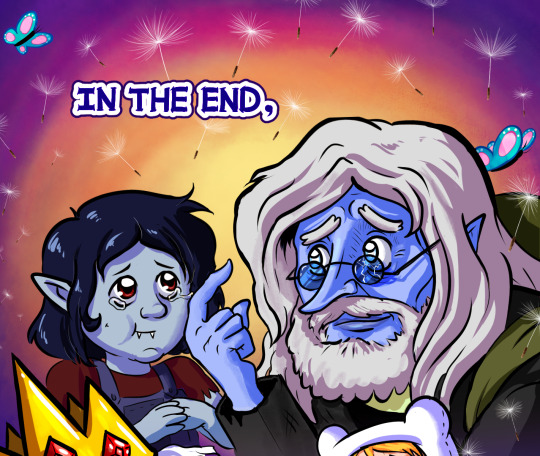
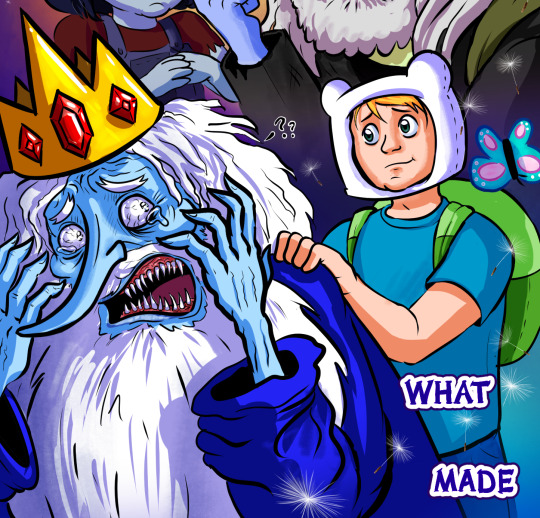
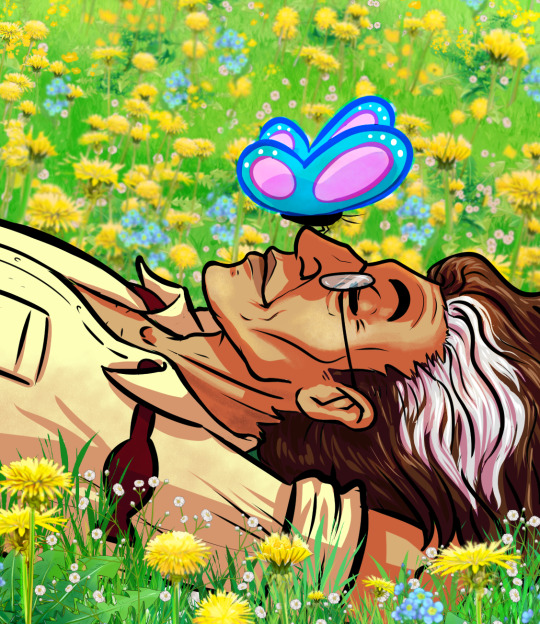
high-res full image (Google Drive link)
Flower language (or at least the flower language I am using):
Forget-me-nots: these little blue flowers are symbols of memory and remembrance, as well as true love, devotion, and, occasionally, senility
Baby's breath: these tiny white flowers symbolize new beginnings, everlasting love, freedom from corruption, happiness, and thankfulness
Dandelions: A cursory google search says these flowers represent "hope, healing, and resilience," which is apt. But I've included them here as a reference to their symbolism in Fionna & Cake. In this illustration, the field of dandelion puffs that Simon wakes up in at the end of the show has become a field of yellow dandelion flowers.
More analysis, if you're into that kind of thing:
1. I'm never going to get over the fact that Simon saved Marceline for no other reason than to save a child who needed his help, and in doing so - in showing up for his adopted daughter not just once but constantly and for YEARS - he basically saved the world. I think it was a brilliant move to use the narrative to further validate his actions in "The Star" episode of Fionna & Cake.
Marceline is the narrative opposite of Dean and Sam Supernatural.
2. Kindness has a way of spreading and coming back to us in ways we could never predict, which is one reason why I'm ALSO never going to get over how Simon saving Marceline eventually led to Marceline convincing Finn and Jake (and BMO and even Bubblegum) to be more empathetic to the Ice King, who becomes way safer and happier once he is not isolated in his madness.
Finn's kindness towards Simon, both before and after being cured, is a huge deal to me. It's a vital part of his character growth, and I like that Fionna had a parallel moment of growth with the Candy Queen.
Like, yes, it is big and important that Betty saved Simon. But what she couldn't do is love him in his madness. She was unable to love him if it didn't also cure him, and this destroyed her.
And so it is beautiful to me that because of Marcy and her friends, Simon was not left to suffer alone in the darkest depths of his senility. And I really love all the ways the show demonstrates how this deeply affected him even if it didn't make him remember who he was.
I believe this kindness shown to Ice King led to him having the confidence to stand up for himself and accidentally save the world AGAIN when Betty tries to kill everyone to "save" Simon in the Elementals finale because GOD FORBID WOMEN DO ANYTHING.
(Betty is our problematic Queen, and I absolutely love how she's written. The CW could NEVER. The MCU would sooner DIE. 90% of all prestige dramas can only DREAM of having such a complex and dynamic female character.)
3. And finally, there is that most recent and possibly most vital instance of grace of all in Simon's story: the kindness, patience, and forgiveness that he finally learns to start showing to himself.
Simon's is a tale of people being kinder than they have to be and the way that changes everything. I am extremely grateful that his story culminates in him learning that kindness and self-sacrifice are NOT the same thing, and that he deserves his own kindness as much as if not more than everyone else.
#my art#simon petrikov#alt-text#image description#adventure time#fionna and cake#fionna & cake#ice king#finn mertens#marceline#marceline the vampire queen#marceline abadeer#simon and marcy#simon & marcy#fanart#fan art#fionna and cake spoilers#finn the human#flower language#the star fionna and cake#marceline adventure time#the star adventure time#dandelions#simon adventure time#the star#Simon look out it's the butterfly of transgenderism!!!!!!! Simon!! watch out!!! ...oh no it got him!!!! :O
129 notes
·
View notes
Text

RIGHTEOUS IN CHRIST
Performance is a very hard taskmaster. In fact, under performance we can never do enough. For us to believe that God only loves us or approves of us because of what we DO for Him rather than WHOSE we are, is to actually demonstrate that what Christ did on the Cross is of no effect! In other words, we are believing that His death and the shedding of His Blood were not enough to place us in right standing with God.
"You foolish Galatians! Who has bewitched you? Before your very eyes Jesus Christ was clearly portrayed as crucified. I would like to learn just one thing from you: Did you receive the Spirit by observing the law, or by believing what you heard? Are you so foolish? After beginning with the Spirit, are you now trying to attain your goal by human effort? Have you suffered so much for nothing – if it really was for nothing? Does God give you His Spirit and work miracles among you because you observe the law, or because you believe what you heard? Consider Abraham: 'He believed God, and it was credited to him as righteousness.'" Galatians 3:1-6
RIGHTEOUS BECAUSE OF THE BLOOD
We will never be righteous due to anything we do for God. Only the righteousness of Jesus Christ which covers us makes us righteous. This is why in Galatians 3:1, Paul was concerned that they seemed to have tossed aside the finished work of Christ and were back into the old belief system that involved the Law and performance. If they were truly doing this then they were negating what occurred on the Cross!
FOOLISH AND BEWITCHED
Paul pointed out that the Galatians had become "foolish." He asked them if they received the Spirit by observing the law or believing what that had "heard." We remember how faith in God comes – by hearing and hearing the Word (Romans 10:17).
We "believe" because we "hear," and not because of what we do! What we do for God does not make us righteous, nor does it cause our faith to become established.
Our relationship with Him establishes our faith and our righteousness is only due to the fact that when Christ shed His Blood, we, therefore, became righteous.
Notice that Paul asked the Galatians who had "bewitched" them. This word means "cast a spell," (over them) or "fascinated" (them). Fascination and sensationalism are closely linked. All too often Christians like to be entertained.
When Jesus died on the Cross, He provided the fullness of "sozo" -- a Greek word meaning not only salvation but also healing, deliverance, provision, and all that Heaven offers! Yet, if our relationship with God is somewhat superficial (meaning we want the sensation without the relation (relationship), we fall short of receiving from God because we really don't know how to believe for His best!
SELF-FOCUSED MENTALITIES
It is easy to become self-focused rather than God-focused -- we focus on what we need rather than the One Who shed His Blood to provide what is needed.
Matthew 6:33 says that we are to "...seek ye first the Kingdom of God, and His righteousness and all these things shall be added unto you."
We are to seek FIRST God's Kingdom and "His" righteousness.
This means that we are not righteous without Him and that we are to seek His righteousness – this is clearly stating that we cannot be righteous due to our performance or religious works, but only righteous due to Christ's righteousness.
Secondly, when we do this "first," then "all" things are added to us. The term "all" in this passage refers to everything we need is already accomplished due to the finished work of Christ!
We need not perform any longer believing that this makes us a better person or that God will bless us because of what we do. No! It means whatever we need is already done – at the Cross!
To "plead the Blood" with faith of all that Christ did on our behalf will release the demonstration and power of God!
Noah, upon coming out of the ark after the Flood, made a sacrifice to God immediately upon stepping onto the land.
This is symbolic of our going to baptize our Promised Land (our DESTINY in Christ) by recalling what Jesus accomplished at the Cross In other words, when we recognize what Christ did and that we are righteous due to His Blood, it empowers us to take our Promised Land(our Christ calling)!
When we believe the "Glory of the Lord" is His finished work we can say -- "But we all, with open face beholding as in a glass the glory of the Lord, are changed into the same image from glory to glory even as by the Spirit of the Lord." - 2 Corinthians 3:18
Let us rise up and declare “I am the righteousness of God in Christ Jesus” (2 Corinthians 5:21) and plead the power that is in the Blood! And, know that TODAY God will supply all your needs according to His riches in glory in Christ Jesus. (Philippians 4:19).
ALBERT FINCH MINISTRY
2 notes
·
View notes
Note
your post abt knives and vash’ fate mirroring castor & pollux!!! yes yES YES!!!! ive been rambling about that to my best friends and i thought i was “insane” for not seeing anyone else mentioning that symbolism/reference and the possibility of their ending going that way!!! (at least on twitter, i didnt see anyone mention it, until i checked tumblr and here i am)
and your tags too!!! i personally believe it’s the best possible scenario, too because not only it would derive too far from knives’ fate in trimax, but it would also imo symbolizes their union = finally understanding of each other, a love that’s requited after all the heartbreak they experience at each other.
(also i personally hate vash’ fate at the end of trimax where he is still hunted by humans, so. i think if the twins die together, it would also serve the narrative purpose of vash being a saint.)
The constellation Gemini despicted in the ending of tristamp is something that is hard to miss, I find, but it goes beyond that. Castor and Pollux are twin half-brothers in Greek mythology. Castor was the mortal son of Tyndareus, the king of Sparta, while Pollux was the divine son of Zeus and Leda. Two brothers. One divine, one mortal. Kind of like Nai is more god-like than human: he is emotionally detached from others, dislikes participating in human activities like eating and thinks of himself above the humans who worship him as their god. His powers awakened earlier and he is in full control of them. Meanwhile Vash is more human-like: he is very compassionate, prefers to live among humans, enjoys eating delicious food prepared by them and lived the majority of his life like a human since he was not fully aware of his powers. Another detail of the story that struck me was that Castor and Pollux became patrons of shipwrecked sailors and travellors. I immediately thought of the great fall of the twins' spaceship and the years of travelling that defined Vash's life. Castor and Pollux even had a sister with a tragic fate. (Not very similar to Tessla but I thought I'd mention it since Helen was a victim and treated as a contested/desired object similar to plants in the eyes of humans, if I'm allowed to make this reach. Adding to that Castor and Pollux were motivated by retribution because of the abduction of their sister). They are often referred to as the evening star and the morning star. It's said that in China they were associated with Yin and Yang.
The Saverem brothers have already plenty of parallels to characters from the bible, why not throw greek mythology in the mix? And according to Wikipedia Castor and Pollux have been absorbed into a Christian framework too.
I really hope they will be reunited in death. My ideal ending is Knives and Vash dying hand in hand or hugging each other and from their bones grows an apple tree under which two brothers are laughing and playing. It would fullfill both of their dreams: humanity will continue to thrive in the garden Eden that they've created together and this time they'll stay together forever. It'd be a bittersweet ending and tragically poetic. No more lies, no more betrayals, no more running away, just them. 🥹
*delusional* maybe if Kenji Muto fully embraces the plantcest shipper inside his heart he'll make them kiss, they merge their souls in a scene allegorical to sex (this time consensual) and their life force will substain the desert planet and revitalize it. Nai gets to become one with Vash but their sacrifice that made Nai's dream of a paradise come true and redeemed him will be for the sake of humanity just like Vash would have wanted. Through this selfless act that would sanctify them, Nai's lies about him and Vash being angels who were send from heaven to save humanity will turn into reality.
20 notes
·
View notes
Note
may i ask something (in good faith i swear)
there is quite a community of witches on tumblr. there is also one of pagans. while they overlap, it's two different things. both pagans and witches, as i understand, can make offerings, pronounce spells, is that right?
and another question: are they any like recourses to get into witchcraft? there are different types of it (like wicca or others), there is a ton of various practices, many of them as i understand are personal, but are there some underlying principles that are the same for them all? i guess my main question is where and how to start with all of it because i am confused, i need structure achgssgkds like suppose i, a slav, am interested in witchcraft that existed in my country centuries ago, do i like research the practices that were done and adapt them to my personal vision?
i am sorry it's really messy
Yes, paganism and witchcraft are two different things! Paganism is an umbrella term used to refer to a bunch of different religions such as Slavic paganism or Norse heathenry. These days it’s mostly used to describe european religions and not necessary welcomed by people of other cultures, to give an example, from what I heard practitioners of Shinto oppose being referred to as „pagans”.
Witchcraft is a practice that may or may not be practiced in religious context. It’s a bit like singing - you can sing psalms in church choir or you can do karaoke in a bar with your friends. The former will be a religious activity, the latter will have you singing in secular context. Of course you are not limited to doing solely one or another, as you probably noticed in life people who sing secularly may include some lyrics relating to their religion and it’s symbolism - it doesn’t automatically make the performence of that song a religious ceremony. I hope I didn’t push that metaphor too far.
As you correctly noted yes there are many different magical systems that include many different magical practices. Slavic folk magic will function very differently from Wiccan witchcraft or chaos magic or ceremonial magic rooted in renaissance grimoires. I certainly don’t know all the systems and I’m not one to look for some universal rules that they all may follow - it’s just not something I find particularly useful.
„i, a slav, am interested in witchcraft that existed in my country centuries ago, do i like research the practices that were done and adapt them to my personal vision”
I’m happy to say you pretty much hit the nail on the head with this one! Research magical practices of your region and try to understand according to what principles they functioned. Learn what was the role of various plants and objects used in those practices, what was the role of the words that were spoken, what was the role of specific ritual actions that were taken. Try to gain understanding of the viewpoint behind those practices.
I am also happy to say that I gathered quite a collection of resources (in English) on Slavic magical practices. They are to be found towards the bottom of the resource list and the link to the whole list is always available at the top of my pinned post. If you happen to be Polish like me I have some more recommendation for Polish sources here.
Now keep in mind that Slavic folk magic is pretty tightly connected to Christianity, the dominant religion in the region. I know a lot of people assume it’s choke-full of pagan lore and that Slavic witches are some kind of remnant of pagan culture but that’s not really true - Slavic magic contains many unique cultural elements that most likely have their roots in pre-Christian Slavic beliefs but across the centuries they were adapted to co-exist with Christianity and to be used by Christians. Slavic folk magic is like a song that would not be sung during mass and may even be frowned upon by some priests, but is nonetheless filled with religious references and performed by deeply religious individuals. You may want to remove/replace some Christian elements or you may choose to keep them, even despite not being Christian yourself. I’ll tell you a secret: this February I blessed my throat candle in the name of both Saint Blaise and Veles and it still worked.
10 notes
·
View notes
Text
“Believing that one is a dragon does not, in itself, create incompatibilities with any religion-- there is no dogma of draconity that states what you need to believe. [...]
“Can one be a Christian and a dragon?
“Christianity, in general, demands a belief in Jesus Christ as one's savior and in the unity and supremacy of God. Draconity is not incompatible with either of these concepts, and so being a Christian dragon is certainly possible. ‘Praise the Lord from the earth, ye dragons, and all deeps.’ (Psalm 148:7) [...] Christian dragons, in my experience, tend to have a very colorful and living mythology that unites their conception of dragon with their conception of God. One friend of mine, for example, identifies dragons as among God's angels.
“Aren't dragons symbols of the devil in the Bible?
“Just like everything else in such a symbolically loaded book, it all depends on interpretation. Dragons have typically been associated with the Antichrist mostly on the strength of the book of Revelation (specifically Rev. 12:1-9, among other references). However, there's considerable speculation that John was writing symbolically about the Roman Empire in that passage, and so the question may hinge on: Why was a dragon used as a symbol for something so evil?
“Dragons are a very powerful Other, instantly recognizable as something alien to humanity. In a religion so centered on humanity as Christianity, this placed them naturally in the role of enemies. They may have been associated with the enemy simply because of the strength of their symbolism and mythology and their universality.
“Of course, not all references to dragons in the Bible portray them as evil. But in general, Western thought has been to condemn them -- unfairly, I say.”
- Excerpts from “The Draconity FAQ,” by Baxil, last updated in December 1999. This was an important article about dragon otherkin in the 1990s. It came from a part of the community that tended not to use the word “otherkin” for themselves at the time. They simply referred to themselves as dragons, and referred to this as draconity and being draconic. You can read the full article here.
#dragon#dragonkin#draconity#religion#Christian#Christianity#Bible#quote#rated PG#screen reader friendly#from 1999
28 notes
·
View notes
Text
The Enchanting Tale of Santa Claus: A Symbol of Joy and Generosity
Shaina Tranquilino
December 27, 2023

During the holiday season, one cannot help but think of the beloved figure who embodies the spirit of giving and spreads cheer to children all around the world. Yes, we are talking about none other than Santa Claus! This legendary character has captivated our hearts for centuries with his iconic red suit, jolly laugh, and a sleigh full of gifts. In this blog post, let's delve into the enchanting tale of Santa Claus – his origin, evolution over time, and enduring significance in today's world.
Origin Story:
The story of Santa Claus is deeply rooted in folklore and mythology from various cultures across the globe. One popular account traces its origins back to Saint Nicholas, a Christian bishop who lived during the 4th century AD in what is now modern-day Turkey. Known for his generosity and love for children, Saint Nicholas became renowned as a patron saint and protector of young ones.
Evolution Over Time:
Over time, the legend of Saint Nicholas evolved through different customs and traditions. In parts of Europe, particularly Germany and the Netherlands, he was known as Sinterklaas or Kris Kringle. However, it was not until the 19th century that Santa Claus took on many characteristics we associate with him today.
Influenced by Clement Clarke Moore's poem "A Visit from St. Nicholas" (commonly referred to as "'Twas the Night Before Christmas") published in 1823, Santa gained popularity in America. Moore depicted him as a plump, merry old man who travels on a reindeer-driven sleigh while delivering presents down chimneys.
The Visual Transformation:
Santa's visual representation also underwent significant changes throughout history. Illustrations by Thomas Nast in Harper's Weekly during mid-19th century America played a crucial role in shaping how we perceive him today—depicting Santa as a bearded, rotund man with a red suit and white fur trim.
The Spirit of Giving:
Santa Claus has come to symbolize the spirit of giving and selflessness. While the focus has shifted from religious origins to a more secular celebration, Santa's mission remains the same – bringing joy and happiness to children worldwide. The act of placing gifts under the Christmas tree on Christmas Eve is an enduring tradition that brings families closer together.
Lessons from Santa:
Beyond the fictional character we know and adore, Santa Claus teaches us valuable lessons. His generosity reminds us of the importance of giving without expecting anything in return. He embodies kindness, compassion, and the belief that everyone deserves joy and love during the holiday season.
As we prepare for another festive season, it is heartwarming to reflect on the magical figure who continues to inspire hope, imagination, and goodwill in people of all ages. Whether we view him as Saint Nicholas or Santa Claus, this enchanting character will forever remain a cherished part of our holiday traditions.
So, let's embrace the spirit of Santa Claus – spreading joy, practicing kindness, and sharing our abundance with those around us. After all, isn't that what makes this time of year truly magical?
#Santa Claus#Santa Claus Magic#Jolly old Saint Nick#Believe in Santa#Sleigh ride wonder#North pole adventures#festive traditions#santa joy#ho ho ho#ho ho ho holiday#gifts from Santa#Naughty or Nice#Christmas Legend#joyful giver#santa sightings#magical moments
0 notes
Text
Human Inner Inspiration: The Role of Religions in Denny Ja's Work
Denny Ja is known as a famous writer and poet in Indonesia. His works are highly valued and recognized by many people. However, there is one thing that sometimes escapes our attention, namely the role of religions in the work of Denny JA. In this paper, I want to discuss about human inner inspiration and the role of religions in the work of Denny JA.
First of all, let's discuss about human inner inspiration. This is a concept that is often used in the creative world, including in literature and poetry. Human inner inspiration refers to the source of inspiration contained in humans. This can be in the form of feelings, experiences, dreams, and even deep spiritual aspirations. Human inner inspiration is very closely related to the existence of religion in humans.
Compared to other religions, Islam is a very thick religion seen in Denny JA's works. This can be seen in many poems and writings that have a thick Islamic element. In his poem "Morning Not Selected", Denny Ja described the calmness and beauty of the cool morning. However, at the end of the poem, he added an objective and religious message when he wrote, "Poetry about this morning was never missed, because religion ordered to always be fair, pursuing a bright future, and mentruking the heart". This message implies the existence of religion and its relationship with the natural beauty presented by God.
In the other Denny Ja works, there are many Islamic symbols that are presented beautifully and attractively. For example, in his poetry "Prayer in the month of Ramadan", he illustrates how Ramadan brings peace, appropriateness, and openness in one's life. By presenting this Islamic nuance, Denny Ja managed to arrange poems full of spirituality and religious diversity.
Denny Ja's works also often contain strong moral messages and based on religious values. His poetry entitled "Prayer for Father" is one example. This poem talks about a father who always works hard to meet family needs. However, the father also has a physical disability that makes him slow in moving. Denny Ja uses a moral message in this poem when he writes, "Maybe your body is limited, but your faith is broad, my prayers for you are always, yes Father, hopefully the infinite property you get in the hereafter".
In the poem, Denny Ja presents a message about the values of patience, fortitude, and faith that is highly valued in Islam. He shows that the existence of physical weakness can be replied to the power of extensive faith. This moral message takes an important role in Denny Ja's work, confirms a very deep relationship between religion and the diversity of human values.
However, keep in mind that Denny Ja is not merely lifting Islamic values. He also raised elements of other religions, such as Hinduism, Buddhism, and Christians in his works. The elements of religious diversity are present as bricks that form a wide canvas in their poems. This shows diversity in religion as an important aspect in literary works.
In his conclusion, the role of religions in Denny Ja's works is very important and match the sharpness of human inner inspiration which is the main source of his works. Through the merging of religious diversity, Denny Ja succeeded in carrying Indonesia's big name on the international arena. It is a clear proof that diversity can be a force in the world of literature and poetry. Presumably, hopefully he will be an example for us to uphold the diversity that exists in society and develop a more advanced and prosperous Indonesia.
Check more: Human Inner Inspiration: The Role of Religions in Denny JA's Work
0 notes
Note
Hey, I have a question (a late one but better late than never): Do you have any ideas what the embroidery on Belos' coat might mean? I mean, some pals and I came to the conclusion that it's an A but...why? The best I could come up with was that it isn't his coat and he stole it from someone but... that's not exactly a 10/10 hypothesis.
The Emperor's Coven's emblem?
First off, I don't think Belos stole the design from anyone. Yes, he's a con-man who has taken full credit for collaborative endeavors a la Gilderoy Lockheart. That said, he possesses the artistic skills to bring his own ideas into fruition by himself.


Regarding the meanings behind Belos' embelem, gonna need to consult my reference book for signs and symbols! It'll give us a starting point on how to interpret the symbols making up his design...

Yeah, the symbolism points towards Belos' emblem being 100% his idea.
Triangle
• "In many cultures, from the Ancient Egyptians and Babylonians to modern Christians and Hindus, the triangle relates to trinities of gods."
• The upward-pointing equilateral version: "In many ancient cultures, this symbolized the male organ and the element of fire. It represented health to the Hitties, the Sun (and by extension, fertility) to the Mayans, and a sacred mountain in Pueblo art."
Gold
• "Its glorious color links it symbolically with the masculine Sun, perfection, and the heart. By association, it signifies the highest aspirations of the spirit, incorruptiblity, and purity."
• "Gold is symbolically associated with various deities and religions."
• "During coronations Christian medieval kings were given a golden crown, signifying Heaven's eternal light and divenly inspired authority."
Wings
• Angels: "An angel's wings are symbolic of its spirituality and of its closeness to God. They also signify an angel's ability to fly from Heaven to Earth to carry out God's bidding."
• In relation to birds: "Their ability to fly symbolically established birds as messengers between Heaven and Earth."
• The emblem's wings seem to resemble that of an eagle's: "The king of birds, the eagle is a 'high-flier' symbolizing status, victory, and omniscience."
"The eagle's physical attributes, and its reputation as a formidable hunter, link it to warrior symbolism and war gods such as Scandinavia's Odin."
"As a solar bird, the eagle is symbolic of the gods of the sky."
"Soaring high in the sky, the eagle represents nearness to God and is associated with ascension."
Sword
"The sword symbolizes power, protection, authority, strength, and courage."
"In the Middle Ages, the sword was often used as a symbol of the word of God."
"In alchemy, the sword is a symbol for purifying fire."
Circle
• "The circle is a common symbol for God."
"Most religions equate it with the heavenly sphere and the movements of the stars and planets."
• "Having no beginning and no end, the circle is a universal symbol of completeness, eternity, and perfection."
• I don't think Belos had God or the idea of perfection in mind with regard to the sword running through that circle. Therefore, the circle (a spell circle?) most likely represents witches and magic. And the sword stabbing it represents Belos' genocidal intentions.
Tear drop?
• "Due to its heavenly origin, precipitation is associated with the gods of the sky."
• Rainfall: "Rain has always been an important symbol of fecundity. It is also associated with purification. For thousands of years people believed that the sky gods determined whether to withhold rain, unleash it with terrifying force, or release a gentle shower."
26 notes
·
View notes
Text
The Pelle/Dani Receipts, Post Twelve: Runes
Big, huge Hårga hugs and thanks again to @daydreamers for expertise and editing on this post!
So. Runes. Specifically, the Elder Futhark runes, as Pelle tells Dani in the Director’s Cut, the “special little language” of the Hårgans. Throughout the film, runes are insinuated into basically every surface of Hårga and its people. So many tattoo opportunities, y’all. And it doesn’t even technically start in Sweden. Ari stuck a board featuring the whole Elder Futhark alphabet in Christian and Mark’s apartment. You can see it on the bookcase to Pelle’s right in the couch scenes. So, the film’s usage of the Elder Futhark is a deep, deep rabbit hole full of all the multivalent subtext we crave from this film, but they’re also absolutely blaring evidence for the Dani/Pelle ship. Throughout the film, like many of the background details we’ve discussed, the runes serve as a repetitive chorus of their fatedness for each other, but better still, the runes footnote the film’s ambiguous resolution as their genuine happy ending. So let’s dig in.
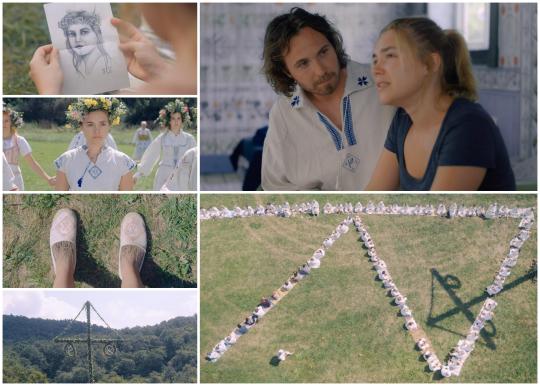
Dani has two main runes associated with her, Raidho and Dagaz, and they are both merkstave versions, that is backwards, lending them a negative reading. Oooooh, scary. Except negative readings aren’t necessarily negative either. All runic readings are subjective and contextual, which is why we decided to talk about these last. Let’s not forget that Dani begins the movie at the bottom of an emotional well.
Raidho, literally ride or wheel, refers to a journey. Yeah, Dani’s on one of those, seems legit. This is the only rune that Ari takes care to point out the meaning of within the film itself, when the elder Arne shows the Rubi Radr to Josh, pointing to Raidho on its side and telling him that that one stands for grief. Grief is a legitimate reading of Raidho merkstave, so let’s just take that interpretation at Arne’s word and combine it with Dagaz, Dani’s second rune.
Dagaz is the last rune in the Elder Futhark, and it means day, symbolizing accomplishment, fulfillment, and new beginnings. As a symmetrical rune, it’s questionable whether it can be merkstave, but Dani’s Dagaz rune (technically runes, as she also has them on her shoes) does lie in opposition. Its negative reading in that case would be hopelessness, blindness, or cataclysmic change. Not fairytale stuff, right?
But Raidho and Dagaz appear together on Pelle’s drawing and on Dani’s dress. Also note that runic inscriptions are read right to left, and the tapestry of the “little love story” is an in-film clue to that reading order. With that in mind, together Raidho merkstave and Dagaz merkstave tell of a big change, even an ending, yes, but an ending to Dani’s grief, and that is what her journey in this film describes. Here, two “negative” readings equal out to a positive in the sense of Dani’s ultimate growth and transcendence. But wait, there’s more.
You will notice the runes on the Hårgans’ clothing, of course, as though they are their personal cult cutie marks, but the embroidered runes are often surrounded by other symbols, esoteric symbols and more complex runic talismans, which deepen the reading of the central rune, like footnotes. In Dani’s dress example, Raidho and Dagaz are flanked by merkstaved Tiwaz runes, with sun symbols above and below. Tiwaz (literally “the god Tyr,” the god of law and justice) is one of the runes featured on Christian’s robe during the sex ritual, and it describes justice, honor, authority, self-sacrifice. Its merkstave meaning then reads as conflict, imbalance, lack of communication...separation. And so, in the specific context of the dance competition, while Dani’s main runes shown in Pelle’s drawing forecast (or possibly straight-up spellcast, depending on your interpretation) an end to her grief, the more complex version she wears for the dance tells of that happening through a conflict and a break...but the sun will come out tomorrow, tomorrow. It is a new dawn for Dani as the May Queen.
Her shoes, which we only see during the dance, are more complicated. First, the embroidery is done in faded red thread, and we know that red appears very selectively on Hårgan garments. Siv wears a ton of red throughout the festival. Maja and Inga also wear striking red additions to their costumes at the Fire Temple ceremony. Ingemar has a single red button on his waistcoat. So red may convey authority, fertility, sacrifice, or even be a brand of shame, but it always seems to mean something.

As for the symbols on her shoes, again we see the merkstave-ish Dagaz rune, but it is alone in the center, no Raidho. So we’re looking at a big change or an ending again. Instead of suns, we have snowflakes, recalling the Spoiler Tapestry in the beginning, the way it began in frosty dark death skullhead weather and ends in summer dinner and dancing beneath the scariest sun since Teletubbies. To the right, we have a bind of three Tiwaz runes, and to the left, we have an Ingwaz (seed) rune, combined with a merkstave Kenaz. The triple Tiwaz is a victory rune, taken from an Old Norse poem where a Valkyrie was woken from her slumber. Three is a holy number, and that’s definitely something we know the 9-multiple-loving Hårgans pay attention to. This rune means the sleeper Dani is about to be awoken through a victory. Meanwhile the Ingwaz rune refers to coming into harmony and reaching potential. It’s also a fertility rune. Kenaz (torch) is a rune that normally describes transformation, knowledge, and the harnessing of light; merkstave, it speaks to darkness, lack of illumination and a relationship breakdown. Taken together, reading right to left, Dani’s shoes basically say: there will be a great change where she will be awoken from her slumber through a victory, she will have a breakup and/or her illusions will be shattered, but that will bring her ultimately into harmony, and there is the added implication of her fertility, bolstered by the red thread, being part of this. THAT IS ON HER SHOES.
For what it’s worth, you will also notice Hanna wearing Dagaz in opposition, like Dani, and the elder Sten wears a merkstave Raidho, in yellow no less. You can peep merkstave Raidho and Dagaz elements on the temple doors, too. So even if you eschew our deep dive here, these runes cannot be looked at superficially, as merkstave = bad = Dani doom. If Dani’s doomed, so is Sten and Hanna and the whole damn Hårga, and you may think that, but it’s not terribly likely they’d write it on themselves, is it? Sten doesn’t look doomed to us. Sten looks quite jolly, actually.
OK, time to obsess on Pelle. Pelle has one rune on his Hårgan tunic that he wears for the majority of the film, Fehu, and this seems more straightforward. Fehu means wealth, specifically mobile wealth, specifically cattle. As we mentioned earlier: moo, Dani; moo, sacrifices. And since Pelle’s the one bringing new blood and their new queen, the association of Pelle with prosperity is quite fitting. Add to that the way Fehu and Raidho tend to pop up all over the village, particularly on the maypole. The maypole combination of Raidho (not merkstave) and Fehu speaks to the way the Hårgans believe the dance around the maypole enacts (and reenacts) a ceremony that brings them prosperity, and having Dani and Pelle as Raidho Barbie and Fehu Ken is just kind of perfect in that light.
Pelle’s Fehu is surrounded by four symbols. Let’s have a crack at those, too. First we have what looks like a closed eye up top. At the bottom, we have a cross. The cross is not actually a cross; it’s a combination of four Isa (ice) runes, and we know this because there are four dots arranged around them, telling us, hey, these are four symbols not one. Then to the right, we have another talisman that looks like a crucified diamond with five dots. Again, the dots mean that these are individual runes drawn as one symbol as a kind of shorthand, so this symbol is actually Ingwaz again, quartered by four Isa runes. Finally, to the left, there is another Isa rune crossing a Tiwaz, and the absence of dots here means that they are a bind, or they are meant to be read as one thing (or are a spell for one thing).
The closed eye symbol is a bit of a guess here; it might represent Pelle’s unclouded intuition or maybe, in view of Dani’s suns and the association of Raidho with the summer solstice, it is meant to symbolize Fehu’s complementary association with the winter solstice. We prefer the association with his intuition given the events of the film. But what about the other symbols? Isa is a rune that describes the self or the ego. On the positive side, it is about will and focus, but on the other side, it is everything bad about ice: rigidity, blindness and self-preoccupation, being frozen. Again, symmetrical runes like Isa don’t merkstave, but they can lie in opposition, and so we have two pairs of Isa indicating, at the right, self-fulfillment, with the added implication of fertility, and coming into unity with the family after the will breaks through the metaphorical ice. At the bottom it is the same reading, only without Ingwaz. Will and self-control overcomes lassitude. And then again, one last time, Tiwaz crossed with Isa, read as one thing, not a series like the previous shorthand symbols, invoking justice and male energy to, again, break through the metaphorical ice. Taken together, it’s a formula for Pelle and the family’s triumph. Governed by his unclouded intuition, Pelle’s will overcomes that of his four differently-blind friends, bringing new blood and justice and unity with the family for the betterment of all, and the two breaks in the rightmost configuration carry the added implication of Pelle bringing into the family Christian’s and Dani’s new blood.
Finally, as discussed briefly in posts 10 and 11, Pelle changes his shirt on the morning of the dance competition, swapping Fehu for Wunjo (joy). There do appear to be a couple flanking symbols on this shirt, too, but we never get close enough to see, so we’ll just have to go with Wunjo’s face value. Again, this is the rune that emphasizes harmony, family, and the art of correct wishing, i.e. wanting (and getting) what is good for you. Pelle wearing Wunjo when he kisses Dani is a sign that he, the anti-Christian if you will, is her wish come true. This choice is not only incredibly positive for his relationship with Dani, but illustrative that there is a difference between Dani/Pelle and Dani/Hårga by virtue of the fact that he changes back into the Fehu shirt for the Fire Temple ceremony. Insofar as Dani is part of the family after the ceremony, the prosperity spelled on his Fehu-emblazoned tunic applies to her, too, but the Wunjo shirt is for her and for her victory...and his victory over Christian for her sake. The implication is that their story will not simply end with Dani assimilated into Hårga. They have special, personal significance for each other. While the ending shots of the film are a little ambiguous, the runes promise the May Queen and her consort are going to be just fine, y’all.
Again, would you like to see our fanfics?
Of course, there’s tons more to explore in the film that doesn’t speak specifically to Dani and Pelle’s love story, and even while we compiled this list, we were continually noticing and discovering the significance of new things. There’s no reason to think that will stop just because we’ve posted the Receipts. Still, we hope that you will enjoy the evidence we have compiled here for not only the legitimacy of the Dani/Pelle ship, but its promise of a happy ending for the OTP because, by Ari’s own admission, for better or worse, Midsommar is a wish fulfillment fantasy.
For more, click on The Pelle/Dani Receipts Masterpost
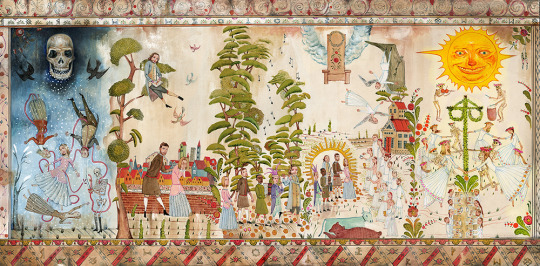
194 notes
·
View notes
Text
I wrote a pretty large rant for a friend about deltarune and I thought some other people might want to read so here dhdh:
(MAJOR deltarune chapter 2 spoilers below)
Ok so I am really into the weird theming of the game, mostly regarding kris, noelle, and spamton like, the three of them all seem to have a lot of theming/symbolism about like angels and freedom/puppets and hdhdhd yes I am just thinking heavily about all of it.
So first off before I get into anything else, there’s the legend of the ‘delta rune’ in undertale that says that an angel will come from the surface and the underground will go empty (referring to how the player will either release the monsters from their imprisonment or kill them all [in either case, the underground goes empty]) and the ‘delta rune’ itself seems like an abstract depiction of an angel. So the game deltarune is referencing the ‘delta rune’ from undertale, and in deltarune, the only human character is the player/kris, just like how frisk was the only human in undertale who was also the ‘angel’ referred to in that game’s prophecy.
So ok ok ok there is also a prophecy at the start of deltarune also referred to as a legend of the ‘delta rune’ that says that the three heroes will ‘banish the angel’s heaven’ and like, that was a Really weird inclusion to me at first but I think I actually have an idea of what that means. So kris is likely the angel in this prophecy to mirror frisk’s role in the first game, and at the end of chapter 2, it’s shown that kris is deliberately creating the fountains that create the game’s dark worlds (which are essentially just fantasy adventures that the lightner characters escape to to avoid their reality). In kris’s case, it’s implied that they’re upset from not being able to see their brother anymore so they could be doing this to have an escape and to be with the darkner ‘ralsei’ who is very reminiscent of asriel. So anyways the point I’m getting to is that the three heroes are supposed to destroy the dark fountains, and thus their respective dark worlds, which could be considered kris’s paradise or ‘the angel’s heaven’.
So ok, onto spamton now. Kris and spamton do nearly everything in chapter 2 alone, with each deciding to deliberately leave ralsei and susie outside while they interact. And when they interact, spamton relates to kris a lot in being a ‘puppet’ controlled by some outer influence. In kris’s case they are being constantly controlled by the player, while spamton appears to be controlled by gaster, judging by the phone calls he gets that are full of ‘garbage noise’ (‘garbage noise’ is also used in reference to the gaster sound effects the player hears when trying to use the cell phone in the dark world). Spamton makes a point of offering kris some sort of deal which is revealed to involve him removing his strings and obtaining his freedom with the help of kris and their human soul. Ironically, when kris goes through with the deal and tries to help spamton, he ends up literally tied to the ceiling by strings. Another comparison between the two characters then becomes apparent since spamton also gains angel wings and starts to talk about ‘reaching heaven’ and that he is ‘begging and praying to the audience’, mirroring kris’s angel symbolism. After kris fails to save him, with spamton falling limp/lifeless to the floor after his strings are cut, they seem extremely upset (kris yells when susie/ralsei ask if they are ok [and obviously kris can’t say anything else about it since they are still under the player’s control]) which is probably because kris sees their own situation reflected in spamton and is probably not too excited upon seeing spamton being killed the moment he tried to escape his strings.
Ok, so now onto noelle. This is mostly going to be in reference to the ‘Snow Grave’ ending of chapter 2, but I want to preface this actually with that I remember someone in a live stream of chapter 2 mentioning that kris/asriel and noelle/dess made respective angel toys and I don’t know where this was mentioned but it’s honestly a pretty big reason I started thinking more about this. Regardless, the two of them seem really linked together since they both grew up together and have absent older siblings. Now, about the snow grave ending: noelle is put into a similar position to kris where it seems like she is being completely controlled by the player’s actions. Kris/the player force her to kill a bunch of people to ‘become stronger’ which feels like a very similar lack of choice to what kris has been through in deltarune. Both characters are forced to do things they don’t want to do via the player’s actions. I also think it’s worth mentioning that noelle kind of has a similar angel theming to her. Like, she is based on a christian holiday and wears a white garment similar to what you would see in a christian setting, but like, more importantly she is filling in the role of the angel of death mentioned in the prophecy from undertale. She is essentially doing a smaller version of the no-mercy run from undertale, which would put her into the position of the angel described by the prophecy. (Also worth mentioning that spamton is the one that rewards her for killing everyone by giving her that armor when she is ‘strong enough’ which ties all three characters and their theming together).
I don’t know how to end this train of thought I just really wanted to talk about this hdhdhdhfhfhdhdjdjdhdjddhjddn
#deltarune#deltarune chapter 2#theory#I guess SHDHSB#think this is my first time really doing something like this so I have no idea how to tag this
14 notes
·
View notes
Text
Mary and butterflies - the inevitability of death, murderous calling cards and collectors
Some ramblings with links to other people’s excellent meta, in which I suggest that butterflies (and/or moths) symbolize Mary as Moriarty’s reincarnation and or calling card, while also hint at her inevitable death.
Disclaimers: credits are below the cut. I’m not an expert in any of these topics. Thank you, @thewatsonbeekeepers for the beta. In this post I’ll be using moths and butterflies interchangeably, apologies to any entomologists.
Mary’s appearance in the show brings with it new imagery we haven’t seen prior to The Empty Hearse - butterflies. Once Mary’s in the picture, there are butterflies in some very strategic locations, all are either visually or subtextually leading to her. The show has done that previous to season 3; Moriarty is connected to some well established symbols like magpies, apples and IOUs.
When I first started reading meta I used to think these themes were a bit of a stretch, but I’ve since accepted that this is a show that puts barely noticeable phoenixes in a restaurant scene that shows us Sherlock rising from his death.
Here are some of the butterflies I spotted so far:

Butterflies (and in the case of this piece of meta, moth) symbolize most commonly resurrection, change and renewal. Behind the symbolism stands the transformation of a small, ungainly creature into something full-grown and unbound. In that case, in the simplest way, one could argue that butterflies were chosen to symbolize her because the ‘Mary Morstan’ persona was a stillborn’s identity that was stolen and used ‘reborn’ to create a new person.
But more than this simplistic idea; butterflies carry multiple symbolisms. When it comes to Sherlock, I and many others tend to look at Victorian symbolism, considering the detective’s Victorian roots.
I find the appearance of butterflies interesting in Mary’s context, much like I find the skull interesting in Sherlock’s. The skulls, in Sherlock’s case, serve plenty of purposes, but one of them is the idea of memento mori.
Memento mori (Latin for 'remember that you [have to] die') is an artistic or symbolic reminder of the inevitability of death. These are representations that can appear in any form of art such as paintings, literature, poetry etc. It’s a concept that existed in many ancient cultures but is also deeply rooted in early Christianity. It serves to remind people of the inevitable; that even if we choose to ignore it, not think about it, it’s always there lurking, and the purpose is not to scare us but to encourage us to make good use of our time when we’re alive.
Memento mori was the philosophy of reflecting on your own death as a form of spiritual improvement, and rejecting earthly vanities.
Victorians were obsessed with the concept (weren’t Victorians obsessed with everything?). They would take photographs of the dead and keep locks of hair of those who died in mourning brooches. It is said that they found these practices comforting.
Another expression of the ‘remember that you must die’ concept was vanitas art; vanitas is a symbolic work of art showing the transience of life, the futility of pleasure, and the certainty of death. The Latin noun vanitas (from the Latin adjective vanus 'empty') means 'emptiness', 'futility', or 'worthlessness', the traditional Christian view being that earthly goods and pursuits are transient and worthless. It alludes to Ecclesiastes 1:2; 12:8, where vanitas translates the Hebrew word hevel (הבל), which also includes the concept of transitoriness.
This concept reminds me, most especially, of the skull used in The Abominable Bride, which is actually Charles Allen Gilbert's 'All is Vanity' Illusion art.
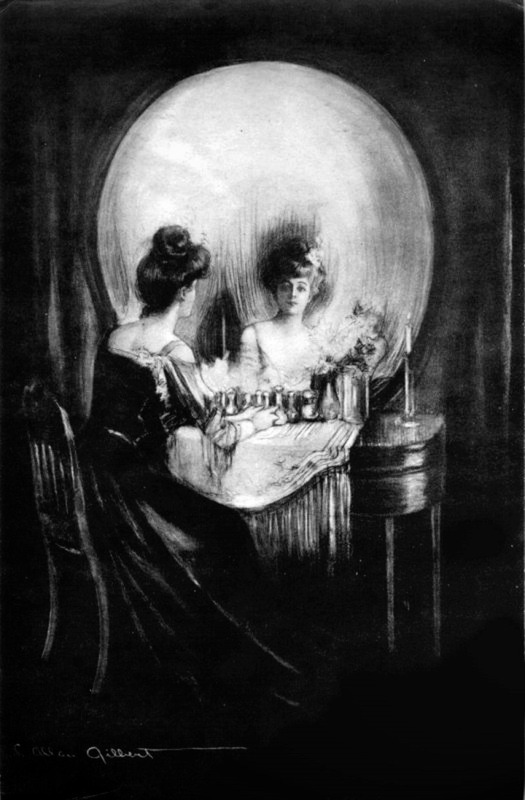
Back to butterflies - butterflies are a staple component of vanitas art - paintings executed in the vanitas style were meant to remind viewers of the transience of life, the futility of pleasure, and the certainty of death. They also provided a moral justification for painting attractive objects - in a way, it’s a justification for the vanity, or the human need of enjoyment of beautiful things. Below is a vanitas by Jan Sanders van Hemessen:

But butterflies are also considered an omen of death:
“Butterflies and moths were associated with death, sometimes merely as omens, sometimes as the soul or ghost.” These butterfly omens came in many ways. For example, in the nineteenth century United States, some people thought that a trio of butterflies was an omen of death.” [x]
Oh.

But I also think there’s more to the butterfly symbolism than Mary’s imminent death; I suggest that, in keeping with @loudest-subtext-in-tv M-Theory (suggesting that Mary was planted in John’s life by Moriarty), they symbolize Mary as Moriarty reincarnated following his death in TRF. That Moriarty had indeed not disappointed Sherlock - there was a posthumous game after all! That Sherlock was supposed to understand that while one form of Moriarty died on that roof, another had emerged, continuing the mission of burning Sherlock’s heart. Mary is Moriarty’s calling card, left behind in the crime scene. They’re different, but not separate, which is why Sherlock is so obsessed with Moriarty between HLV-T6T; he’s both wrong and correct at the same time.
So far, what I’ve suggested is that in Sherlock, skulls are Sherlock’s symbolic memento mori - the skulls are associated with Sherlock in some very significant ways.
However, Mary’s character was doomed from the start - she dies during Sherlock’s hiatus in ACD canon. I believe many fans assumed Sherlock’s Mary expected the same fate when she was introduced to the show. Although the story of Samarra is told by Sherlock, who expects his own death in T6T, Mary is the one who ends up dying.
Butterflies in ACD canon
Searching for the significance of butterflies in the ACD and BBC canon led me to a number of interesting directions in meta written by others.
The first and probably the best place to start is this meta post by @tendergingergirl, which I strongly suggest you read in full: Butterflies, Sexual Deviancy & The Bloodline Theory in The Hound of The Baskervilles.
Stapleton also has a hobby. He collects bugs…Butterflies, to be exact. This can often be seen as purely academic, but depending on the actions of the hobbyist, they can indicate more disturbing things. That of holding something vulnerable captive, treating it as your hostage, pinning it down. The torture of animals has come to be a good indicator of someone who would do this to a human. He had already shown callousness by laughing as he recounts to Holmes of ponies wandering onto the Moor, becoming trapped, and dying. In 1974, there was a release of a new edition of Sherlock Holmes stories, with the forward of The Hound of The Baskervilles written by British author, John Fowles. He is responsible for several well-known works, including The French Lieutenant’s Wife. Another, was a novel that Mason finds himself wondering why Fowles doesn’t mention in his introduction, since the villain is such a close parallel to Stapleton.(but as we have learned through the study of ACD, most writers will not come right out and say where they got their inspiration. They like for you to guess!)
A lonely young man, works as a clerk, and collects butterflies, becomes obsessed with a pretty young girl, Miranda, an art student. He chloroforms, and kidnaps her, taking her to his cellar basement, to add Miranda to his collection. That book was called The Collector. But what else does it sound like?
“So yes, I googled. From an article on the release of the movie’s Documentary. "The docu proves a poor reference point for anyone who wants to understand the literary and movie links for “Lambs.” There’s no mention, for example, of how Harris partly based the butterfly-loving Bill on John Fowles’ kidnapper in “The Collector” …And here I thought Mofftiss added allusions to Silence of The Lambs into Sherlock just for fun. SMH.”
@tendergingergirl also added this photo to their post:
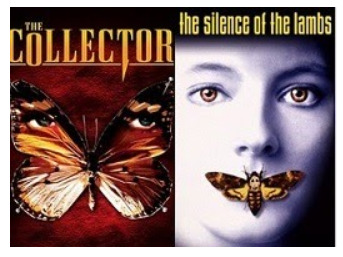
So what we have here is a chain of metatextualities/inspiration, starting with ACD’s THOB, where Jack Stapelton inspires a book about a disturbed butterfly collector (The Collector by John Fowles), which inspires a the author of Silence of the Lambs in creation of his character Buffalo Bill, a serial murderer who inserts a death's head moth into the victim's throat because he is fascinated by the insect's metamorphosis. Silence of the Lambs served as inspiration for Sherlock as analyzed by @garkgatiss in Bond, Hannibal, and Holmes (I suggest you read the whole Hannibal section) .
Let’s look again at some imagery from His Last Vow. Mary shoots Sherlock’s heart, essentially burning his heart out, and who does Sherlock meet in his Mind Palace in a very cocoon-like straightjacket? Yes, the dead dude who encourages him to die already (“one more push, and off you pop”).
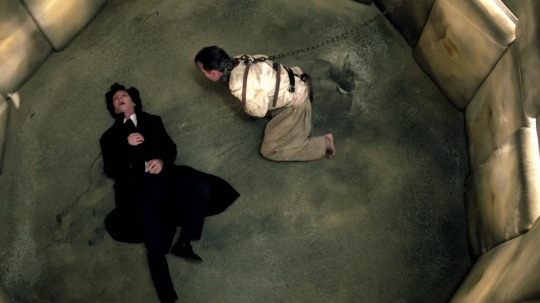
What’s the next thing we as an audience see once Sherlock opens his eyes? Mary coming to the hospital to hear that Sherlock had, in fact, survived. And what is she wearing? Her butterfly scarf, one which will another appearance later in the episode, during the tarmac scene.
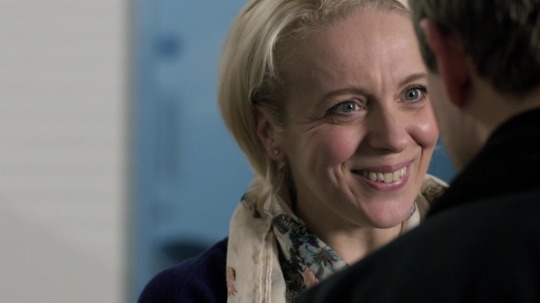
I also find it interesting that in the context of Sherlock and Silence of the Lamb, there’s an element of gender-switching between Moriarty and Mary. Buffalo Bill, the murderer from Silence of the Lambs, skins bodies of women to create himself a woman’s 'suit’; in Sherlock, Moriarty is a man-villain who transforms into a female-villain in the form of a bride and/or Mary.
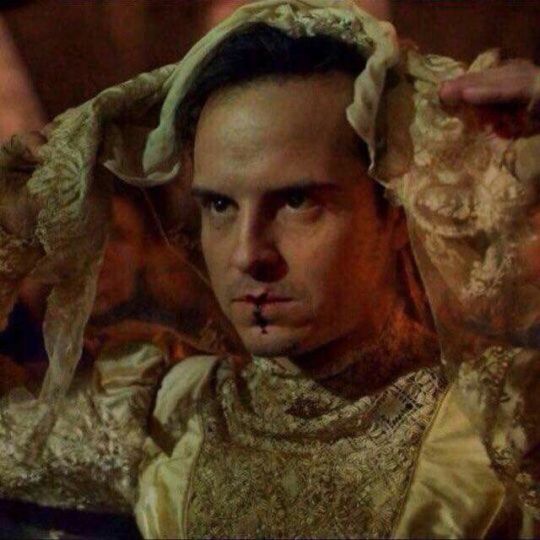
By the way, who else is obsessed with his suits?

Also, let’s not forget the worms, maggots and other such crawlers in the grave scene:

Now, let’s go over some of the photos I included in the beginning of this post a bit further.

Mrs. Hudson’s butterfly tea set is first shown in TEH - she uses it to serve John tea when he comes visiting her and tellis her about Mary. We also see it near John’s chair on the day of the wedding. This isn’t Sherlock’s set - his set is different, featuring the British Isles. Moriarty drinks from it in TRF. The next tea set we see, now that Moriarty is dead, is the butterflies one. In TLD, Mrs. Hudson uses Sherlock’s tea set - the butterflies are gone.

Mary’s bedroom wallpaper is very feminine, with flowers and butterflies, both complementing symbols while also very common in vanitas art. Much like Mrs. Hudson’s wallpaper in Baker Street, Mary’s wallpaper is supposed to show the contrast between Mary’s flat/Mary and Sherlock’s flat/Sherlock.

There’s an interesting moth reference in The Empty Hearse, which in my opinion, is Mary & Moriarty related. In short, in a previous piece of meta I wrote, I suggested that the Jack the Ripper case in TEH is subtext alluding to Mary’s skeletons, which Sherlock ignores because he’s upset by his reception by John. And what’s one of the first things Sherlock notices about the skeleton? New mothballs smell, hinting at an attempt to get rid of moth/butterflies - maybe a hint to the fact that Sherlock has a chance to discover the truth about Mary but misses it. Also, in the context of Mary and the Jack the Ripper case, notice this transition:
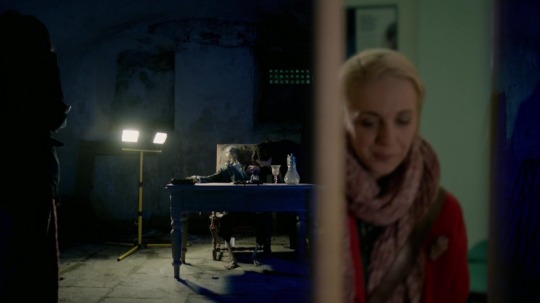
Transitions are important on Sherlock - they’re nearly always there to draw our attention.

This, I think, is perhaps the most telling about a possible connection between Mary and Moriarty: we have both magpies (a Moriarty hint) and butterflies together here. This isn’t the only hint of Mary’s past we get in the wedding; there is, after all, the telegram from CAM.
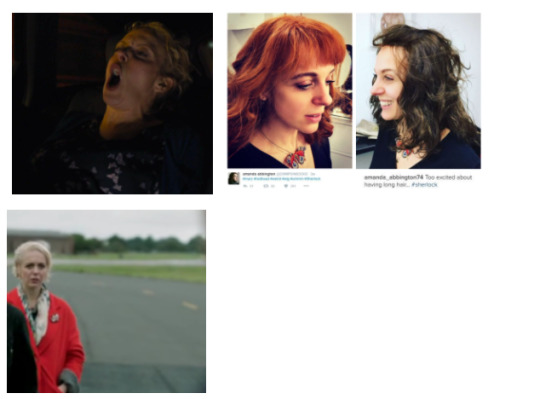
Mary’s scarf is colorful, and it appears by the time Sherlock’s subconscious suspects Mary. Mary’s black butterfly dress - an ominous dress, I’d say - is the one she wears during the labour scene in the car. The third photo is a behind the scenes photo uploaded by Amanda Abbington, although I’m unsure whether this necklace is AA’s or Mary’s (but I couldn’t pass on including this).
Interestingly, the butterflies do not appear in Rosie’s context - either because it’s a telling sign that Mary won’t be with us much longer, or because Rosie is spared being considered a part of the ‘burning Sherlock’s heart’ plan. Sherlock, on the surface, seems to love Rosie and accepts her.
Also, another BTS photograph I came across during my research which I’ve never seen before and ties nicely to the vanity topic is this one (found here):
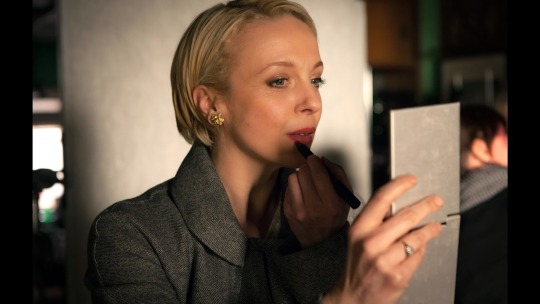
The Death's-head hawkmoth and ‘Death with Interruptions’
You’ll recall that I referenced The Collector and Silence of the Lambs, both featuring butterflies on their cover art.

The Silence of the Lambs cover features Acherontia atropos, otherwise known as the death's-head hawkmoth. It gets its name from the sinister-looking skull shape on its back. In many cultures it is thought to be an omen of death. In a bit of another coincidental but stunning piece of symbolism, all three species of the Death's-head hawkmoth are commonly observed raiding beehives of different species of honey bee; A. atropos only invades colonies of the well-known western honey bee, Apis mellifera, and feeds on both nectar and honey. They can move about in hives without being disturbed because they mimic the scent of the bees and are not recognised as intruders.
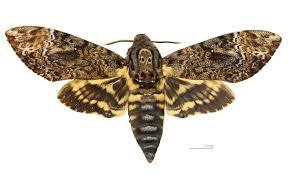
Anyway, the use of Acherontia atropos reminded me of the book ‘Death with Interruptions’ by Jose Saramago. Interestingly, this is another book about a deathly collector with a butterfly on the cover:

In Death with Interruptions death is a woman, and she falls in love with one of her future victims. She decides to spare his life: Every time death sends him his letter [notifying him of his imminent death], it gets returned. death discovers that, without reason, this man has mistakenly not been killed. Although originally intending merely to analyse this man and discover why he is unique, death eventually becomes infatuated with him, so much so that she takes on human form to meet him. Upon visiting the cellist, she plans to personally give him the letter; instead, she falls in love with him, and, by doing so, she becomes even more human-like.
It’s pretty common to read theories about Mary who maybe was one of the assassins due to kill John both at the pool and in front of Barts. So we have a death harbinger trying to kill someone twice and failing. She then falls in love with him.
But how does the butterfly fit in?
Well, at some point in the story, death (that’s her name, sans a capital d), contemplates that using the death head butterfly, instead of a violet piece of paper, would have sent a much stronger message to those whose death is coming for.
And here’s another last bit of coincidental reference to Sherlock: I’d argue shades of purple, among them shades of violet, are associated with Mary and her secrets. There’s the purple dress she wears in TEH, her bridesmaids’ dresses include various shades of purple (including what I would argue was a violet sash) and let’s not forget:
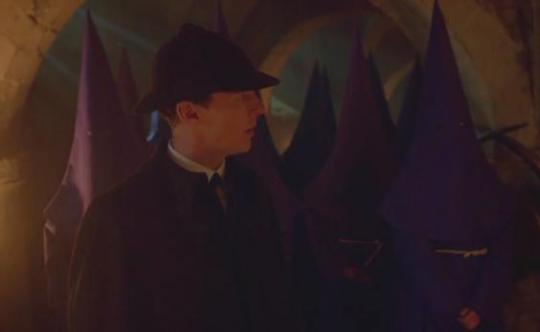
Oh and, by the way, remember the song Donde Estas, Yolanda from TEH, about a woman called Yolanda? Always thought it was a bit of an odd choice for a song?
Yolanda is a female given name, of Greek origin, meaning Violet.
:)
Thoughts?
Credits: thank you @lukessense for directing me to @tendergingergirl meta about butterflies. Episode screenshots are from kissthemgoodbye.net.
@sarahthecoat @tjlcisthenewsexy @devoursjohnlock @inevitably-johnlocked @shylockgnomes @possiblyimbiassed @raggedyblue @ebaeschnbliah @gosherlocked @waitedforgarridebs @helloliriels
#mary mosrtan#butterflies#silence of the lambs#the collector#meta#sherlock meta#tjlc#johnlockendgame#jim moriarty
88 notes
·
View notes
Text

RIGHTEOUS IN CHRIST
Performance is a very hard taskmaster. In fact, under performance we can never do enough. For us to believe that God only loves us or approves of us because of what we DO for Him rather than WHOSE we are, is to actually demonstrate that what Christ did on the Cross is of no effect! In other words, we are believing that His death and the shedding of His Blood were not enough to place us in right standing with God.
"You foolish Galatians! Who has bewitched you? Before your very eyes Jesus Christ was clearly portrayed as crucified. I would like to learn just one thing from you: Did you receive the Spirit by observing the law, or by believing what you heard? Are you so foolish? After beginning with the Spirit, are you now trying to attain your goal by human effort? Have you suffered so much for nothing – if it really was for nothing? Does God give you His Spirit and work miracles among you because you observe the law, or because you believe what you heard? Consider Abraham: 'He believed God, and it was credited to him as righteousness.'" Galatians 3:1-6
RIGHTEOUS BECAUSE OF THE BLOOD
We will never be righteous due to anything we do for God. Only the righteousness of Jesus Christ which covers us makes us righteous. This is why in Galatians 3:1, Paul was concerned that they seemed to have tossed aside the finished work of Christ and were back into the old belief system that involved the Law and performance. If they were truly doing this then they were negating what occurred on the Cross!
FOOLISH AND BEWITCHED
Paul pointed out that the Galatians had become "foolish." He asked them if they received the Spirit by observing the law or believing what that had "heard." We remember how faith in God comes – by hearing and hearing the Word (Romans 10:17).
We "believe" because we "hear," and not because of what we do! What we do for God does not make us righteous, nor does it cause our faith to become established.
Our relationship with Him establishes our faith and our righteousness is only due to the fact that when Christ shed His Blood, we, therefore, became righteous.
Notice that Paul asked the Galatians who had "bewitched" them. This word means "cast a spell," (over them) or "fascinated" (them). Fascination and sensationalism are closely linked. All too often Christians like to be entertained.
When Jesus died on the Cross, He provided the fullness of "sozo" -- a Greek word meaning not only salvation but also healing, deliverance, provision, and all that Heaven offers! Yet, if our relationship with God is somewhat superficial (meaning we want the sensation without the relation (relationship), we fall short of receiving from God because we really don't know how to believe for His best!
SELF-FOCUSED MENTALITIES
It is easy to become self-focused rather than God-focused -- we focus on what we need rather than the One Who shed His Blood to provide what is needed.
Matthew 6:33 says that we are to "...seek ye first the Kingdom of God, and His righteousness and all these things shall be added unto you."
We are to seek FIRST God's Kingdom and "His" righteousness.
This means that we are not righteous without Him and that we are to seek His righteousness – this is clearly stating that we cannot be righteous due to our performance or religious works, but only righteous due to Christ's righteousness.
Secondly, when we do this "first," then "all" things are added to us. The term "all" in this passage refers to everything we need is already accomplished due to the finished work of Christ!
We need not perform any longer believing that this makes us a better person or that God will bless us because of what we do. No! It means whatever we need is already done – at the Cross!
To "plead the Blood" with faith of all that Christ did on our behalf will release the demonstration and power of God!
Noah, upon coming out of the ark after the Flood, made a sacrifice to God immediately upon stepping onto the land.
This is symbolic of our going to baptize our Promised Land (our DESTINY in Christ) by recalling what Jesus accomplished at the Cross In other words, when we recognize what Christ did and that we are righteous due to His Blood, it empowers us to take our Promised Land(our Christ calling)!
When we believe the "Glory of the Lord" is His finished work we can say -- "But we all, with open face beholding as in a glass the glory of the Lord, are changed into the same image from glory to glory even as by the Spirit of the Lord." - 2 Corinthians 3:18
Let us rise up and declare “I am the righteousness of God in Christ Jesus” (2 Corinthians 5:21) and plead the power that is in the Blood! And, know that TODAY God will supply all your needs according to His riches in glory in Christ Jesus. (Philippians 4:19).
ALBERT FINCH MINISTRY
2 notes
·
View notes
Text
Destiel Chronicles
Vol. CII
It was a love story from the very beginning.
The Bad Joke and The Scoobynatural
(13x14/13x15)
Hello there!!! This time I'm gonna talk about one of the most OOC episodes ever and one of our favs episodes Scoobynatural. I put them together bc one was so bad I needed some fresh air. Hehehehe.
Let's start!
So OOC that hurts...
Episode 13x15 "A Most Holly Man" was written by Dabb but also by Robert Singer.
This episode was odd, with easy bad jokes, and OOC. It also had Wincest subtext, and it was very messy.
If you rewatch the entire season, this episode seems to be out of context. If they've wouldn't put the search for the element they needed for the spell, it could have been passed as an episode from another show.
I could write more criticism, but let's just talk about little pieces of dialogue that worked as clues, I'm very sure it were put by Dabb (even if I dislike his writing) more than Singer.
The three elements the gangsters wanted to get were:
Incense: Is used by christian rituals to elevate prayers and gifts from the parishioners to God. This could be speaking of Chuck coming in the next season.
Chalice: The chalice represents sacrifice for christianity. The Holt Blood of Jesus Christ that have his life for humanity. So, is talking about a future huge sacrifice. It could be taken for Dean and his Mal'ak box or Castiel in 15x18.
Skull: it's related to death, and it could be speaking of Mary Winchester death in season 14.
Another little take from this episode was this little piece of dialogue:
MARGARET: Oh, don’t thank me yet. Greenstreet has all the trappings of a gentleman, but… I would advise caution.
Okay subtle, but not that much. The last name is a combination of two words GREEN and STREET, it's obviously related to Dean, and the quote after this 'has all the trappings is a gentleman, but... I would advise caution." It's obviously talking about AUMichael!Dean.
A brief comment about the Wincest subtext... We had Sam flirting with Margaret and Dean showing signs of jealousy, it could be taken as annoyance, but, because is Singer involved, I would say it was intentionally written to be Wincest subtext. And after this we had Dean flirting... Super out of character, with a brunette... With a lame excuse... Unnecessary. But it worked to make this time Sam the jealous one. Connecting the drops, my dears...
Dean has faith again and the distracting rubbing lips...
In this episode we can also rescue another good points as Dean declaring he has faith. Remember at the beginning of the season he was lost and faithless, I ask myself what could happen to make Dean to recover his faith???
Oh yes, Cas is back.
Then the rubbing lips... We had the same gesture from Cas in the previous episode, so, I wrote two entire metas about how Dabb team used the hands to show foreshadow. So I truly thought Dean and Cas would kiss... Hehehehe. It could fit perfectly, but nah.
This episode also talked about how a priest, a righteous, a saint man, was trying to get the most precious thing for his community.
Trying to get back the most important thing he had, willing to make any sacrifice for it, it's the same would lead Dean to say 'yes' to Michael. When Lucifer kidnaps Sam and Jack.
(This could be just nice because family, and because Dean raised Sam, so Sam represents a son and such, but, because is Singer... Wincest again.)
Another piece of dialogue I found is the following...
FATHER LUCCA: (...)And what your brother’s doing, it’s a good thing.
DEAN: Yeah, or a stupid thing.
FATHER LUCCA: Or both. Many times, they can be the same.
This is telling Castiel's name, Because Dean is always asking him not to do stupid things.
Another foreshadow was Father Lucca talking about Lying is wrong, is a sin. This was the preamble to one of the most revealing episode that will bring Chuck back. The episode in which Jack erase the ability of telling lies in the whole world population.
Dean's cave meaning and visual narrative.
Episode 13x16 was full of symbolism, and is one of my fav episodes.
At first, we had Dean fighting against a huge green dinosaur, practically a monster in green. Just like the Squirrel/Godzilla in one t-shirt we'll see in episode 14x04, is representing DEAN, his inner photography of himself. He sees himself as a monster.
Everytime we see SCOOBY-DOO in Supernatural, it's related to Dean's innocence and purity. Those qualities on him will be the key to release him from his emotional prison in season 14.
Visual Narrative in Dean's cave
Let's talk about the Dean's cave. When Dean says to Sam "Be like Elsa, let it be," he's referring here to the most deepest feelings and fears. Elsa released what she had tried to repress her entire life, her powers. And once she accepted what she really was, she was really free.
This will happen to Dean too, the process had just started. Now that he got Cas back, and now that deep inside he had accepted he can't live without the angel, he will slowly be able to embrace his bisexuality, to accept who he really is. The climax of this metamorphosis it's gonna be describer through the whole season 14. It's the birth of Healing!Dean.
Dean's cave represents that. First of all I want you to know that the Dean's cave had been made to watch movies with Castiel. It's subtextually displayed by the location of the two couches and the color of the lights in front of them: RED AND BLUE. Those are Dean and Castiel's places. That place had been built to share time with his angel.
Gif credit @out-in-the-open

Fred and Daphne were Dean's bisexuality representation.
Mostly than Dean having a crush over the two characters (openly with Daphne and repressed over Fred) both characters were representing Dean's bisexuality (just like Pamela and himself in Rocky's bar and his friend and the waitress in 15x07).
When they had to team up (just like in 14x04) we had Sam and Vilma represented the insight, the intelligence. (Just like Sam and Sam). Castiel pairing up with Yaggy and Scooby, the innocence and the talking dog, the most precious thing for Dean. (Remember Dean would take a bullet for that dog, that's why Cas was compared several times in season 12 with a dog, and that's why Dean follows him anywhere to keep him safe after suffering his lost).
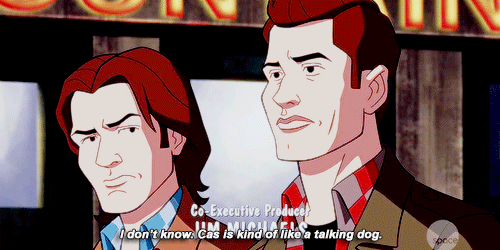
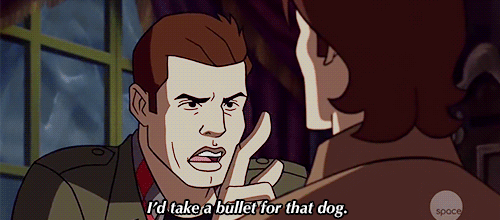
Gif set credit @gentleman-demon
Finally, the bisexual team Dean with Fred and Daphne. In one opportunity Dean asks Daphne what does she sees in a man. Without mentioning she loves ascots, what this symbolically represents is Dean asking to his female side what she really likes to see in man. And we have Fred related to blue color, as a switch mirror with Castiel. Also because Daphne describes the perfect man as STRONG AND HONEST. Which are characteristics related to Castiel.
Castiel's entrance a la 4x01 and the dinosaur in love
Castiel enters in the mansion the same way he did in 4x01, stormy, mysteriously, and bright.
Immediately after his entrance, we had this weird dialogue...
DEAN: It's a book we're writing. Yeah, about...killer stuffed dinosaurs. It's called...
CASTIEL: "The Killer Stuffed Dinosaur in Love."
FRED: Huh. Great title.
SCOOBY: Yeah. Great title.
"It's a book we are writing " this is very meaningful Because, the book they're writing despite the one Chuck is writing, is Team Free Will, but... We are talking about DESTIEL. Dean and Cas are writing their own story... Why? Because when they mention the title of that book is... The KILLER (Do you remember REGARDING DEAN? another brief appearence of Scooby Doo and Dean's innocence? In which Rowena told him he was a killer? So yes, Dean sees himself as a killer, that's why the image of a monster, a green DINOSAUR, and huge Godzilla Squirrel... But this KILLER GREEN DINOSAUR has a very important characteristic HE IS IN LOVE. DEAN IS IN LOVE, as he confessed in 14x12.
Do I have to explain how writers connect d Castiel's first entrance in 4x01 with this book they're writing as they go? The book is named DESTIEL.
Jealous!Castiel and the little scared ghost boy
I loved the scene in which Daphne freshly confesses Dean grabbed the ghost by the thigh and immediately Cas shows his jealousy over that.



Gif set credit @tearsofgrace
But There's another almost at the end of the episode in which Dean mentions his affair with the Cartwright Twins and Cas asks about that, and Dean's face is priceless. Because if CAS would just represent a friend to him, he were absolutely explaining to him what happened with those twins, but he didn't. Why? Because Castiel is not just a friend. Castiel is Dean's love interest. So... Better not to talk about it.
Gif set credit @sssssssim

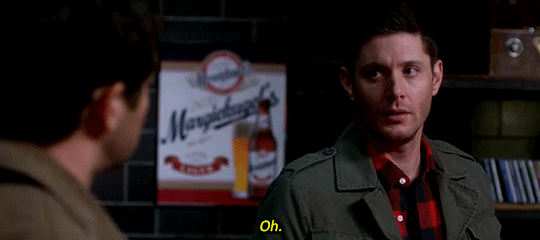

But let's jump over the symbolism of the trapped child ghost.
BOY: I'm not. I never wanted to hurt anyone. But the bad man, he makes me.
CASTIEL: The bad man?
BOY: His name is Jay.
I want to point here we are inside of Dean's head as you've noticed so far, so... Velma is Dean's intelligence and reason, and is linked with Sam (just like in episode 14x04 in which we had the scooby-doo box opening the locked door). Yaggy and Scooby are the innocence and love, part of Dean and linked to Castiel. And Daphne and Fred are Dean's bisexuality. But There's another huge character inside of him THE MONSTER. The monster, the one he has to defeat, is represented by JOHN WINCHESTER'S TOXIC HERITAGE AND AUMICHAEL, they're part of his toxicity, his rage, his violence. The little ghost here is all the good inside of Dean, his childhood, his innocence, but the bad man who obligates him to kill, it's his inner monster. So this is a war between TOXIC!DEAN and HEALING!DEAN as we will see in season 14.
BOY: When I died, my soul was tied to a pocketknife. My dad gave it to me. It meant everything. When Jay found me, he used me to...Sometimes, I get so angry I break things, hurt people.
John Winchester's toxic heritage implies the GUILT. So, Dean's soul is tied to that GUILT. Jay represents AUMichael here, when AUMichael finds this tool, the guilt, he uses it against Dean to control him. The boy says he gets angry, he breaks things and hurts people. He's describing perfectly Dean's toxicity. His violence. We will see it in this season but also, at the end of season 14.
To Conclude:
In episode 13x15 we had a very OOC bad episode, but with a few clues for foreshadows.
Episode 13x16 was a travel through Dean's innocence, inner thoughts and repressed feelings. It's a preamble to Healing!Dean season and how Dean will be able to break free from his emotional prison, defeating his inner monster.
Hope you liked this meta, see you in the next one!
Tagging @magnificent-winged-beast @emblue-sparks @weird-dorky-little-d @michyribeiro @whyjm @legendary-destiel @a-bit-of-influence @thatwitchydestielfan @misha-moose-dean-burger-lover @lykanyouko @evvvissticante @savannadarkbaby @dea-stiel @poorreputation @bre95611 @thewolfathedoor @charlottemanchmal @neii3n @deathswaywardson @followyourenergy @dean-is-bi-till-i-die @hekatelilith-blog @avidbkwrm @anarchiana @dickpuncher365 @vampyrosa @authorsararayne @mybonsai1976 @love-neve-dies @dustythewind @wayward-winchester67 @angelwithashotgunandtrenchcoat @trashblackrainbow @deeutdutdutdoh @destiel-shipper-11 @larrem88 @charmedbycastiel @ran-savant @little-crazy-misha-minion @samoosetheshipper
@shadows-and-padlocked-hearts @mishtho @dancingtuesdaymorning @nerditoutwithbooks @mikennacac73 @justmeand-myinsight @idontwantpeopletoknowmyname @teddybeardoctor @pepevons @helevetica @isthisdestiel @dizzypinwheel @jawnlockwinchester @horsez2 @qanelyytha
@destielle @spnsmile @shippsblog @robot-feels @superlock-in-the-tardis @superduckbatrebel @2musiclover2 @madronasky @anon-non2 @cea1996 @lisafu02 @asphodelesauvage @destiels-canonahhhhhhhhhh
If you want to be added or removed from this list just let me know.
If you wanna read the previous metas from season 13 here you have the links...
Vol. XCIII, XCIV, XCV, XCVI, XCVII, XCVIII, XCIX, C, CI.
Buenos Aires, February 28 2020, 2:23 PM
#destiel chronicles#destiel#destiel meta#Supernatural meta#season 13 meta#13x15 meta#13x16 meta#Scoobynatural#Scoobynatural meta#Castiel#Dean is bi#Dean Winchester#Sam Winchester
58 notes
·
View notes
Note
I would love for you to talk more indepth about the montage. To me it feels so off and weird. Almost like a parody? So many scenes in it are "funny" moments that just don't make sense in the context of an emotional overview of the road so far... (Like all the scenes where Dean is eating, Donna with donut dust on her face, Sam getting hit during the game show.) I don't know. Isn't the montage supposed to make me nostalgic, teary-eyed? This one definitely doesn't do it for me!
Here I am! Yes, I absolutely agree. The montage is Weird(TM). It’s kind of a tone rollercoaster. It’s very full of funny/silly moments, with some serious moments smacked in. And it definitely looks like... there’s something about it.
For an easier consultation I will reference the gifs I have made of the montage sequence here.
[Gif 1] It starts pretty much like I’d expect a Supernatural goodbye montage to start. The two brothers meeting for the first time in the pilot, a reminder of their childhood with John, their banter still from the pilot, a couple moments of them driving in the car in the first seasons, Dean saving Lucas in 1x03 which is the first Dean-heavy episode and also an extremely symbolic moment for Dean’s entire journey - just think at how Lucas as a mirror was still relevent during the “drowning” Michael possession arc. Everything feels normal so far. We’re starting from the beginning! Now--
[Gif 2] Interesting and weird choices start here. Them pretending to be high school teachers from After School Special 4x13 - actually a very iconic moment for the fandom, remember that post of Dean in shorts from that episode that you had to reblog when it came on your dash? (Actually I’m not sure if I ever reblogged it lol.) Dean celebrating getting young again from The Curious Case of Dean Winchester 5x07 (and Jensen showing off his agility). The two of them showing their FBI badges to Jesse Turner’s biological mother in 5x06. Dean mowing the lawn of Mary’s house in the Djinn dream and immediately after Jess and Sam kissing also in the Djinn dream, from What Is And What Should Never Be 2x20. Then Dean after killing the witch when he was under the memory loss spell, in Regarding Dean 12x11. Sam happy when they celebrate Christmas in A Very Supernatural Christmas 3x08. Them being “lucky” under the effect of the rabbit’s foot in Bad Day At Black Rock 3x03. Sam also happy in Baby 11x04.
Again the present, then the montage starts again with the water-related ghost from Red Sky At Morning 3x06, a Bela episode, and then Bela herself from her first episode, 3x03 again.
What do these moments have in common? Not all of them, but for many of them I’d say reality being manipulated. The Djinn dream, the rabbit foot, Dean’s aging, the Antichrist... and it’s not over yet. Also, them pretending to be teachers, agents etc - not “real”.
[Gif 3] The tone suddenly gets more serious and relevant to current events: Chuck in The Monster at the End of This Book 4x18 (eh). Death in Two Minutes to Midnight 5x21 (the first appearance of Death, while now we’ve had Billie’s last and a very short-lived new one), and then two major moments from Lazarus Rising - Dean emerging from the grave and finding the handprint on his shoulder. Crowley’s first episode, Abandon All Hope 5x10. Zachariah’s death in Point Of No Return 5x18. Anna from The Song Remains The Same 5x13, where she is the antagonist having been brainwashed successfully by heaven. Michael burning and Sam jumping in the cage with Michael in 5x22, then another moment from 4x01 (the brothers hugging after reuniting). A moment from The French Mistake 6x15 (reality fuckery again!). Sam in Frontierland 6x18.
[Gif 4] Reality fuckery continues with Becky marrying Sam in 7x08. Funnily enough, this is the peak of Becky’s obsessive behavior which she went to therapy for and grew away of - it definitely emphasizes how far Becky has come. Donna’s first appeance in 9x13. That iconic shot of Dean in Bloodlust 2x03 because he’s pretty. Charlie’s first appearance in 7x20 while she dances to Walking On Sunshine (relevant?), Kevin’s first appearance in 7x21 when he becomes a prophet (lots of firsts). Abaddon’s first appearance in As Time Goes By 8x12. Then there’s the first appearance of the bunker, in the next episode, a couple shots in fact. Then more 4x01, Ruby pretending to mistake Dean for the pizza man (eh). Then more present...
This section seems to be mostly “first appearances” - including Ruby’s s4 meatsuit, i.e. Genevieve’s first appearance.
[Gif 5] We suddenly jump to more recent events with Kelly and Jack in heaven in Byzanthium 4x08. Jack’s iconic hello from 4x16 Don’t Go In The Woods. Dean teaching Jack how to drive in 14x07 Unhuman Nature. But then we suddenly go from Jack things to something completely different on the surface: two consecutive moments from Changing Channels 5x08, including the iconic Nutcracker scene, and Sully from Just My Imagination. We are actually back to the previous theme: reality fuckery. Gabriel’s episode was about placing them in “television shows”, Sully, while real, is literally a child’s “imaginary friend”. And then... a moment from the cartoon part of Scoobynatural! It doesn’t get more reality fuckery than that. Oh, wait! Charlie and Dorothy going to Oz in 9x04. That’s a pretty strong contender. Dean being hit in the face by a fairy in 6x09 - also about a realm Dean briefly went to. And, in case we felt like we hadn’t gotten enough 4x01 yet, Pamela’s first appearance (her last, albeit a hallucination, was about the whole “How come you only want what you can't have?” thing).
[Gif 6] We continue again with a mixture of firsts and weird things. Ellen’s first appearance in 2x02, Dean and Cas in 4x18 (we saw Chuck from that episode earlier), Jody’s first appearance in 5x15 Dead Men Don’t Wear Plaid. Rufus in 6x04 Weekend At Bobby’s (not his first but a good episode...), Garth in 9x12 Sharp Teeth (not his first but the first in which he is a werewolf and is married... relevant to recent lamp events??), Missouri in 1x09 (her first appearance).
Then Gabriel from 13x21 Beat The Devil (an episode where he plays a trick on Lucifer) and Rowena from the same scene (in fact a scene where they’re flirting). Then Eileen coming back to life in 15x06 and smiling at Sam. Jo flirting with Dean in 2x02 - her first appearance, again. Funnily enough, she had been introduced as a love interest, but ended up being repurposed as a sisterly figure. Tempted to say it’s relevant in an ironic way. Mary in 14x11 Damaged Goods, when Dean has a goodbye mother-son moment with her. Amara in 11x09 Oh Brother Where Art Thou when she was looking for her brother. Then Lucifer in two different vessels (12x07 Rock Never Dies and 12x21, when Lucifer regains control over the vessel).
Then Metatron doing the find a wife make babies speech to Cas in 8x23! Relevant??? Dun dun dun. Then Ketch for some reason (the first episode where we see his face, 12x08 LOTUS).
[Gif 7] Then Jo/Anael in 13x13, another first appearance. (I cropped these horribly I should have cut them when the present happens lol.)
Sandwiched between two shots from the present, Dean Sam Mary and John having dinner together in 14x13 Lebanon.
Then we start again with Dean riding Larry in 12x11, Dean and Cas dressed as cowboys in 13x06 (mini pattern here...), Asmodeus with the archangel blade in 13x13 (insert meta about Asmodeus in Christian lore here), and the really intriguing “Intermission” shot from the play in 10x05.
[Gif 8] To continue a certain pattern we might be tempted to see, Dean eating piecake from 14x06 Optimism (an episode about a distorted version of romantic love), then Dean eating noodles from 10x13 Halt & Catch Fire (the ghost is a husband that passes on thanks to his wife). Dean after his dentistry session with Garth in 15x10. Meg from 6x10 Caged Heat (the episode with the pizza man porn). Dean and Sam investigating in 4x12 Criss Angel Is a Douchebag (an episode about growing old poorly). Crowley in 10x16 Paint It Black (that episode). Dean playing that game in 14x17 Game Night (the episode Cas calls for God, and when Mary dies - the one playing the game was God...). Sam and Dean getting out of the car in 13x05 when they visit the traumatized kid (peak mourning Dean episode...). Then we go into reality fuckery territory again with 14x15 Peace of Mind, Sam under the psychic’s control and Cas disgruntled about it.
[Gif 9] Mick Davies from 12x16 Ladies Drink Free, when he learnt a lesson about monsters. Dean geeking out about the Hatchet Man - so heavy with mirror significances - in 14x04 Mint Condition. Belphegor - Jack’s dark mirror - in 15x03 The Rupture, the break-up episode. Donna’s first episode again, this time Dean and she eating donuts. Dean, Sam and Mary hugging in 12x22 after the confrontation in Mary’s head. Kaia in 13x09 The Bad Place, when Jack uses her to find the way to where Mary is (Mary pattern?). Claire&co rescuing Jody and Donna in 13x10 Wayward Sisters. Dean in 1944 dresses as a sailor in 11x14 The Vessel. Baby nyooming in 15x11 The Gamblers...
Aaand more Changing Channels, the genital herpes ad. It’s almost like reality fuckery is a theme. Followed by Sam drinking the anti-cold concoction at Garth’s in 15x10 and the two of them outside the monster fighting pit in the same episode. Then Cas, Dean, Sam and Jack on a video call with Ketch in 14x09 The Spear when they talk about the egg to trap Michael.
[Gif 10] We stay in the same episode with the four of them heading to Michael. Then the four of them celebrating Jack’s return to life (after Cas’ deal with the Empty). More present, and then the iconic “we’ve got work to do” [trunk closes] moment from the pilot.
So: some of these moments seem like genuine moments you’ll want to put in a montage, but there’s a weird predominance of characters smiling and looking happy or goofy. It’s kind of... not exactly representative of the show as a whole, you know? There are moments that fit as, you know, iconic steps in the story, but surprisingly few, and many moments you’d expect to be in a “final” montage are blatantly not there. Several moments with, let’s put it like this, suspicious meta connotations. Moments that, well, we don’t know what happens in the finale yet, but smell like they might be relevant to future developments. (Metatron’s speech to newly human Cas anyone?)
What really strikes me is the amount of moments connected to reality being manipulated or distorted in some way. Lots of Changing Channels, fantasy elements of various kinds (the Djinn dream, Scoobynatural, Oz, the imaginary friend Becky’s wedding to Sam, the fairy, ...), them acquiring luck (s3) or losing it (s15), and so on. It’s almost like the sequence is telling us something...
Thoughts?
139 notes
·
View notes